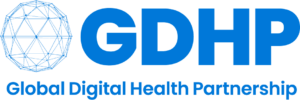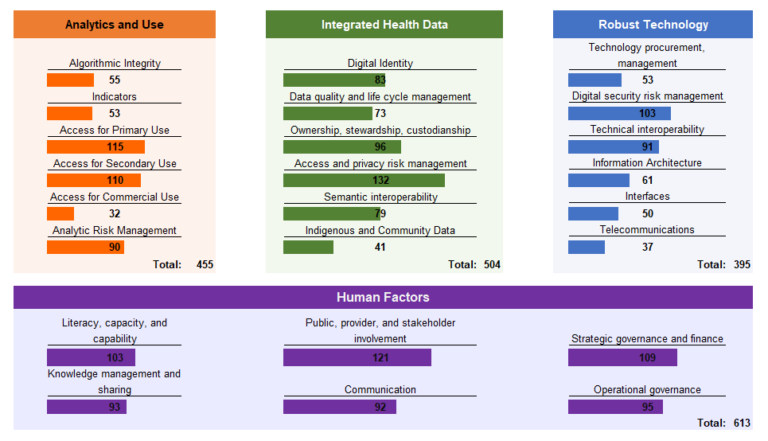GDHP/OECD Policy Repository Tool
International Reference for Digital Health Policy
Around the world, the advancement of digital health technologies and health information system have provided tools to address shared health system challenges – if effectively harnessed. In such a complex environment, the need for cooperation and partnerships that transcend country borders is paramount. The Global Digital Health Partnership (GDHP) and the Organization for Economic Co-operation and Development (OECD) are two international organizations helping facilitate and leverage such connections.
The rapid progress made by these technologies necessitates timely need for action from a policy perspective to ensure appropriate governance and frameworks. In bridging this gap, the Policy Environments Workstream of the GDHP aims to integrate these technologies into both existing and new policy frameworks. Working together, the OECD and GDHP have created the OECD-GDHP Policy Repository Tool (“Policy Repository Tool” or “The Tool”). The joint Policy Repository Tool builds upon the OECD’s existing Policy Checklist and serves as an international digital health policy repository. On a global level, this dynamic Tool allows countries to identify leading practices worldwide around a variety of topics, such as interoperability and secondary use of data. It will allow digital health leaders to understand experiences internationally and pick the best lessons to apply in their context.
There are a variety of use cases for the Policy Repository Tool, including the ability to focus on specific digital health initiatives and country mapping – enabling comparators across countries. Most importantly, the Policy Repository Tool can help facilitate conversations across GDHP member countries and partner organizations to share learnings and further disseminate leading practices in digital health policy around the world. This article will take a more in-depth look at the Policy Repository Tool, including the genesis for its creation, current use cases and an analysis to date. In addition, this article will delve into initial thoughts on the future of this Tool and how it can continue to support international collaboration on digital health policy advancement and evolution.
Context
Digital health advancement has taken on greater urgency in recent years, driven by lessons and after-effects from the pandemic, increased pressure on health systems, increased cybersecurity risks, and opportunities presented by new technology.
As such, countries are increasingly concerned with having the right data infrastructure in place for supporting the delivery of care, producing health statistics, and measuring health care quality and outcomes. Specifically, this includes data linkage between settings and levels of care, and mechanisms to generate and use timely, actionable data to support better clinical care, research, and health system planning.
Interest in strengthening health information systems has grown since the COVID-19 pandemic. This interest has shone light on the importance of having reliable, up-to-date information readily available to inform health system decision-making. The pandemic also showed that more digitized health systems were better equipped to deliver uninterrupted care, all while monitoring and responding to the crisis. As health systems struggle to recover from the surge in care needs and workforce shortages, gaps in access to care and clinician burnout persist and demand solutions. Advancements in information technology offer great promise, if applied effectively. Where there are common challenges internationally, so too is there the potential for common solutions, realized through further cooperation and sharing of best practices worldwide.
Collaborating Organizations


The Global Digital Health Partnership (GDHP) brings together national governments and international organizations collaborating to advance digital health on a global level. The GDHP has five designated ‘Workstreams’ focused on the advancement of different digital health initiatives. GDHP Workstreams pursue tangible digital health initiatives to align activities and accelerate progress around topics like evaluation, clinical and human engagement, and interoperability. Top of mind for all Workstreams is the challenge presented by lack of access to relevant information. Indeed, digital health development and innovation relies upon the access of knowledge and information sharing, especially for rapid dissemination. The rise and application of advanced information technologies means there is a great opportunity for knowledge building, community interaction, innovation, and collaboration.
To that end, the Policy Environments Workstream of the GDHP aims to integrate information technologies into policy frameworks. Ultimately, the goal is to harness their capabilities to transform healthcare globally, ensuring that advancements and insights are rapidly disseminated and applied to improve healthcare outcomes worldwide.
The Organization for Economic Co-operation and Development (OECD) is an international entity where national governments collaborate with various health system stakeholders. Together, all stakeholders exchange evidence and experiences, address shared economic, social, and environmental challenges, identify best practices, and create evidence-based international standards. Drawing on over 60 years of experience and insights, the OECD works to better prepare the world of tomorrow. The OECD is a partner of the GDHP, and an active contributor in its various Workstreams.
Impetus for the Policy Reference
In October 2022, at the 10th GDHP summit in Rotterdam, the first in-person summit following the pandemic, common international themes quickly emerged. Collaboration with GDHP members during the pandemic years had been focused on the response, vaccine deployment and certificates, and virtualization of care. During transition into the recovery phase, there was an increasing acknowledgement of global challenges related to health data, interoperability, and policy. Addressing these challenges became a heightened priority for the Policy Environments Workstream, prompting a call to action to share best practices in policy and seek opportunities for alignment and collaboration.
To meet this need, the Policy Environments Workstream developed the initial ‘Data Collection Tool’, which was further refined through a pilot project. The pilot project involved several early participant countries, and now currently sits at 13 in total. In December 2022, a broader call for country contributions was issued to the Workstream, including a presentation of the work conducted by Michael Peolsson, whose efforts played an important role in laying the foundation for data collection. At the subsequent 2023 Summit in Washington, D.C., the initial data set was shared with the Policy Environments Workstream. Participants found the information collected through the pilot project to be highly valuable and discussed expanding the work. Following this meeting, a broader call for participation was made to all GDHP members.

Building upon the OECD Policy Checklist: The OECD-GDHP Policy Repository Tool
The ‘OECD Policy Checklist’ was first published in the OECD Health at a Glance 2023 Report, in the feature chapter on Digital Health. The Checklist proposes a foundation for policies that support an integrated digital health ecosystem, and overall, is an important reference point to consider the contributions of GDHP members against future benchmarks. It was first introduced as a tool to bring together a high-level checklist of policies for digital health across analytics (including AI), data, technology, and the human factors that hold them together. This enables countries to map their digital health policies to determine their policy readiness, as well as identify existing and future needs. Additionally, this Checklist allows GDHP members to identify leading examples in areas such as privacy and interoperability and provides a centralized location for accessing this information. The OECD is currently working with the GDHP towards publishing an elaborated version of the Policy Checklist in late 2024.
OECD-GDHP Policy Repository Tool
The overarching goal of the Policy Repository Tool is to map an international digital health policy repository to the key functions and policy areas covered by countries, to better compare and discuss approaches and policy frameworks. Currently, the Policy Repository Tool covers 24 policy areas (e.g., analytic integrity, data quality, procurement, public engagement) as elements of digital health policy (as defined in the OECD Policy Checklist) and provides a heatmap of the policy coverage of GDHP member countries, to inform them of where they have policies already in place, as well as gaps. Each country has their own sheet that can be used to both input and view their policy data. For further details on how to use the Tool and guiding principles, please refer to the “OECD-GDHP Policy Repository Tool User Guide.”
Use Cases
GDHP and OECD members can use the Policy Repository Tool in various ways. Some of the intentions for use include:
- Enabling users to view a specific area of interest through a filter functionality (e.g. interoperability, digital ID) and identify leading policy practices.
- Enabling individual countries to map themselves against the Checklist, which will allow them to see existing policies in place and existing gaps within their own country.
- The filter functionality will also further support the user to view gaps, and ultimately compare against the progress of peer countries.
- The Tool provides a useful resource for countries, each at different stages of their own digital maturity journey, to easily identify and learn from the progress of other countries. The learnings can help shape their own country’s policy development.
- In addition, the Tool provides opportunities for countries to focus on areas of common interest and facilitates the building of partnerships and the sharing of knowledge between GDHP members.
There are many other uses cases beyond the ones mentioned above and we hope to capture additional ones as we continue our feedback and update cycles. As the Policy Repository Tool continues to mature, countries will have more opportunities to identify emerging global trends in policy and apply the learnings within and across their own borders.
Initial insights from analysis performed to date
Through a compilation of policy documents from OECD and GDHP members, further themes emerged for consideration. Though there is much variability across member submissions, these themes are important in shaping further dialogue about the Policy Repository Tool.
- Some topics, such as privacy rules and clinical engagement, are commonly addressed, while other topics, such as AI, are not as prevalent. Differences in health systems can account for some variation in themes. Through all the submissions, it is important to note that no member has comprehensively addressed the policy foundations for digital health. From a learning perspective, everyone stands to gain from this awareness and the Policy Repository Tool can help by further facilitating conversations around these topics.
- While there are many opportunities to exchange leading policy practices, certain focus areas will benefit from global alignment. For example, Interoperability within the realm of legal, organizational, technical, and semantic aspects. The global nature of patients (e.g., cross-border patient flows and the necessity of receiving care outside of their home jurisdiction), corporations, and disease, requires an international need to communicate and share health data when it is most needed. International alignment on interoperability standards can allow the patient’s information to ‘follow them’ in case of an emergency, and/or for out of country care.
- International interoperability will also benefit other stakeholders in the larger ecosystem. Electronic health record providers can streamline their efforts and resources required to build interfaces and develop new solutions with a standardized, global market in mind.
- The seamless flow of information will enable public health emergencies to be more effectively monitored across borders and mitigate the impact of future pandemics. To realize these benefits, international agreements and aligned policies must be in place across borders, addressing the legal, regulatory, security, and privacy concerns related to sharing health data.
Impression: policy heatmap

Next steps
- First, there is an opportunity to develop a formal update and submission process for countries looking to submit new and updated documents. This will not only grow the number of submissions, but also increase the trust in the Tool through having the best and most up to date information available.
- Another upcoming opportunity includes further analysis of the strategy documents in the Tool. This would entail conducting a thematic analysis across these documents to identify common themes and areas of focus. Not only will this allow for a centralized view of these themes and areas of commonality, as well as differences, but it can also be used by other countries to support their own strategic plan development, based on the leading practices and ideas identified in the analysis.
- An additional opportunity is the inclusion of another filter feature that would enable deep dives into various emerging topics. Similar to filtering by country, this additional filter feature could allow countries and organizations to gain further insight into leading practices around the world on a specific topic of their choosing (e.g. digital ID), that can help inform their own strategic and tactical planning.
- Finally, future features will include further content and could also involve identifying different components of policies themselves that foster and support collaboration across borders. By identifying collaborative policies, the Tool can further improve co-operation between and within countries and encourage collective action on shared problems and solutions.
Conclusion
There are many health system challenges that need to be solved, but with limited digital health policies and strategies in place to tackle them. In the ever-changing and complex world around us, the need for collaboration, for learning, and for knowledge sharing cannot stop at our country borders. The OECD-GDHP Policy Repository Tool can play an important role in helping countries create their own strategies and policies by connecting them with their international peers to share best practices.
As outlined above, there are many exciting opportunities for future work involving this Tool. As it continues to mature, additional information and features will be added to it and further use cases will be identified. The relevance of the information to our members, trust in its accuracy, and speed of updates are critical in maintaining the momentum that has been generated. The dedication, buy in, and contributions of our member countries and organizations are essential for its continuing development and success.
